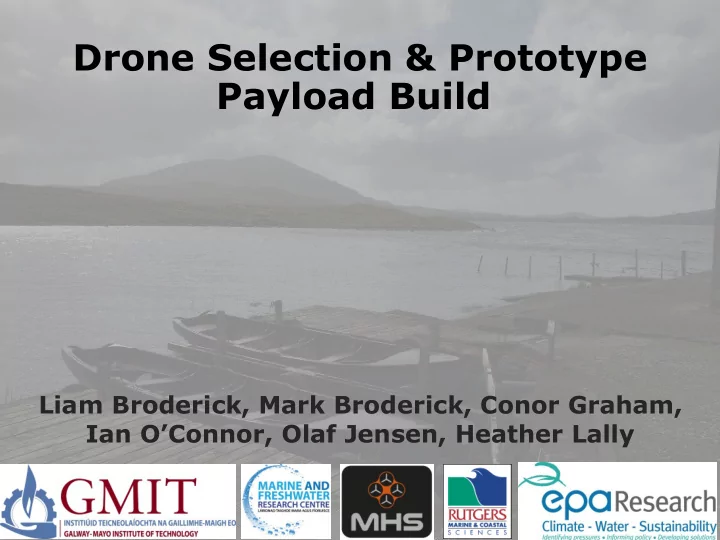

Drone Selection & Prototype Payload Build Liam Broderick, Mark Broderick, Conor Graham, Ian O’Connor, Olaf Jensen, Heather Lally
Which drone to use? Objectives: • Critically evaluate all types and sizes of rotary aircraft currently available on the market for their suitability to conduct water quality sampling and monitoring. • Select a drone platform for payload adaptation allowing water samples and physico-chemical data collection.
Which drone to use? Initial Requirements to meet project goals: • Drone must be able to lift a slung payload of 6 kg. • Fly for a minimum of 10 minutes • Fly 200 m carrying this payload weight. • Capability to fly in wind speeds up to 8 m/s. • Drone including the payload must not exceed 15kg • Must be capable of providing “loss of a single motor” redundancy. • Must have GPS + GLONASS capability with redundancy available between them. • Retractable undercarriage. • First person view (FPV) integrated zoom camera of at least 12 MP .
Which drone to use? • Suitable for dual operators where the camera movements can be controlled by a second operator with two compatible pilot / camera HD monitors supplying a live view with HDMI output. • The primary controller must be able to provide additional channels available for integration with the payload. • The controller system must allow for software development kit (SDK) integration. • The radios must operate on primary EU ISM Band 2.4 GHz transmission with optional 5.8 GHz backup. • Drone must give real time telemetry information for the duration of the flight. • Drone and all its accessories must be CE approved.
Drone Selection Matrix Name of Manufacturer Size UAV Maximum Flight Flight Wind Waterproof EU Regulatory UAV (diagonal) weight payload speed duration speed Legislation† mm (kg) weight (m/s) (mins) (m/s) (kg) Matrice DJI* 1133 10 6 17 16 8 Splash proof Open category 600 Pro (including – A3 batteries) Register UAV operator with IAA Conduct theory Skymatri Prodrone** 1534 13.2 20 (10 l 16 13 - 25 8 Waterproof and flight x X-FI spray tank) and for use in exams all weathers Hold third party insurance PD6B – Prodrone** 1348 11.5 30 16 10 - 30 10 Specific - Type II category – SOP required Agras DJI* 1833 18.5 16 (16 l 10 10 8 Spray proof Register UAV T16 (excludin spray tank) operator with g IAA batteries) Include risk assessment Agras DJI* 1500 & 10 10-14 (10 l 7 20 - 22 8 Spray proof MG-1P & 1515 (excludin spray tank) MG-1S g batteries) *Data on DJI UAV models was taken from the DJI official website www.dji.com **Data on Prodrone models was taken from the Prodrone website www.prodrone.com † EU Regulatory Legislation pertains to the new EU Implementing (Commission Implementing Regulation (EU) 2019/947) and Delegated Regulations (Commission Delegated Regulation (EU) 2019/945) which take effect of 1 st July 2020. See www.iaa.ie/general-aviation/drones for more information.
Selected Drone DJI Matrice 600 Pro
Prototype Payload Build Objectives: • Investigate various water sampling attachments (payloads) in operation. • Examine the applicability of using standardised physico-chemical probes as sensor attachments to the payload. • Explore the safest means of operating the package on site, particularly for take off and Landing modes. • Consider communication needs between the operator and attached payload. • Assess the ability of the drone to remotely store and transmit physio-chemical data.
Prototype Payload Criteria Retrieve 2 litres of water from 10 cms below the surface of the lake. Water sample must not be contaminated by the system Collect and log “time stamped” chemical measurements when in the water Final weight suitable for drone transportation Automated payload operation from water entry to exit Waterproof and completely buoyant
Prototype Payload Build The payload build and design is subject to a non-disclosure agreement (NDA) and is currently deemed to be commercially sensitive
Prototype Payload Build Key features: • Prototype payload weight is 6kg outbound and 8kg inbound. • A remotely operated camera and “live link” verifies payload operations. • Flight time from take off to return is 6 mins, including sample time in the water of around 3 mins. • Altitude for flight was maintained at less than 15 m in all cases. • Samples were taken more than 100 m from the lake shore.
Prototype Payload Build • Collection of a 2 L water sample and in-situ real time chemical analysis was collected with 100% reliability. • Operational testing on site verified that Safe “One person” Take off and Landing remote from the shoreline can be deployed in difficult locations if required. • An emergency release has been incorporated and tested should the payload become fouled or drone performance deteriorate
Prototype Payload Build Limitations encountered during field trials Limitations UAV with attached water sampling payload Weather Limited by wind speeds greater than 8 m/s Limited by moderate – high rainfall levels Payload Payload weight should be less than 10kg Payload swings in the wind UAV Operational carrying capacity of M 600 drone Personnel Must have experienced, licensed UAV pilot
Recommend
More recommend